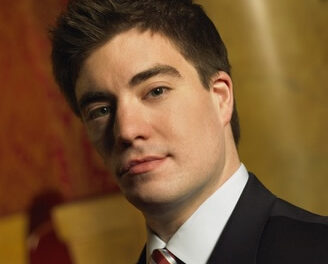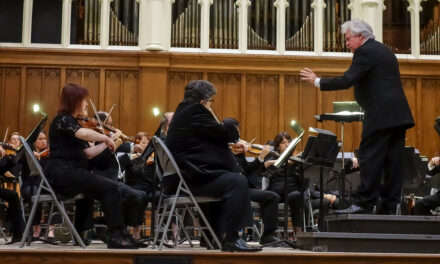The acoustically excellent Recital Hall of the University of North Carolina Greensboro was nearly full for the second Monday night chamber music concert of the Eastern Music Festival. Faculty players were featured in a sandwich of 19th century Romantic works surrounding a late work by a 20th century Japanese composer that served to cleanse the palette between the rich, long established masterpieces.
The First Sonata No. 1 in E minor, Op. 38, by Johannes Brahms (1833-97), underwent a major rewrite and cuts before the final version was established. Originally planned as a four movement work, three movements were composed in 1862. An Adagio second movement was dropped and the finale was completed in 1865. Brahms makes extensive use of aspects from the Contrapunctus 3 from J. S. Bach’s Art of Fugue in the first movement and there are subtle hints of Contrapunctus 13 in the passionate final third movement. marked Allegro.
The performers were cellist Julian Schwarz and pianist Awadagin Pratt, who has performed frequently on series throughout the state. The lid of UNCG’s Kawai piano was fully raised, but Pratt’s mastery of balance with Schwarz was everywhere evident. Their interpretation of the opening movement was remarkable. Schwarz brought out the broad depth of the cello’s dark lower range Brahms sought to exploit. Pratt paired this with some of the most refined and delicate playing I have ever heard. Their interpretation of the second movement made a strong brighter contrast to the largely dark mood of the opening. Any dynamic restraint on Pratt’s part was tossed in his powerhouse opening of the finale. Schwarz matched him with plenty of heft from his cello. They brought some fascinating new insights to this well- known work.
I confess there are two musical instruments for which I have little taste: accordions and marimbas. I approached Rain Tree for vibraphone and two marimbas (1981) by Tōru Takemitsu (1930-96) with considerable trepidation. It dates from the composer’s late period, when he returned to composing with more commonly recognizably solid tonal centers. Rain Tree is part of his Waterscape series, about which Takemitsu’s “intention was to create a series of works, which like their subject, pass through various metamorphoses, culminating in a sea of tonality.”
The musicians were vibraphonist John Shaw and marimba players Matt Decker and Eric Schweikert. In addition to these large instruments, each player had a series of beautifully pitched sets of small metal bells that were often allowed to fully expend all their colorful overtones.
Much of the writing for the vibraphone and marimbas consisted of crystal clear pitches and delicate exploitation of tonal color and overtones. I was often reminded of the sound of drops of water falling from a cave’s stalactite in a deeply resonant space. Fast paced episodes challenged my perceptions. The work and performance was fascinating.
The much beloved Piano Quintet in A, D.667, by Franz Schubert (1797-1828), brought the concert to a richly satisfying end. Its five movements include a theme and variations fourth movement, based on the composer’s song “Die Forelle” (The Trout). The performers were violinist Shawn Weil, violist Chauncey Patterson, cellist Amy Frost Baumgarten, double bassist Meredith Johnson, and pianist William Wolfram. To describe the performance as gemütlich would be to short-change the great precision of their performance. Rhythmic interplaying was excellent. The string players produced rich, warm tone. The piano’s balance with the strings was ideal. This was simply as fine of realization of “The Trout” as I have ever heard.












